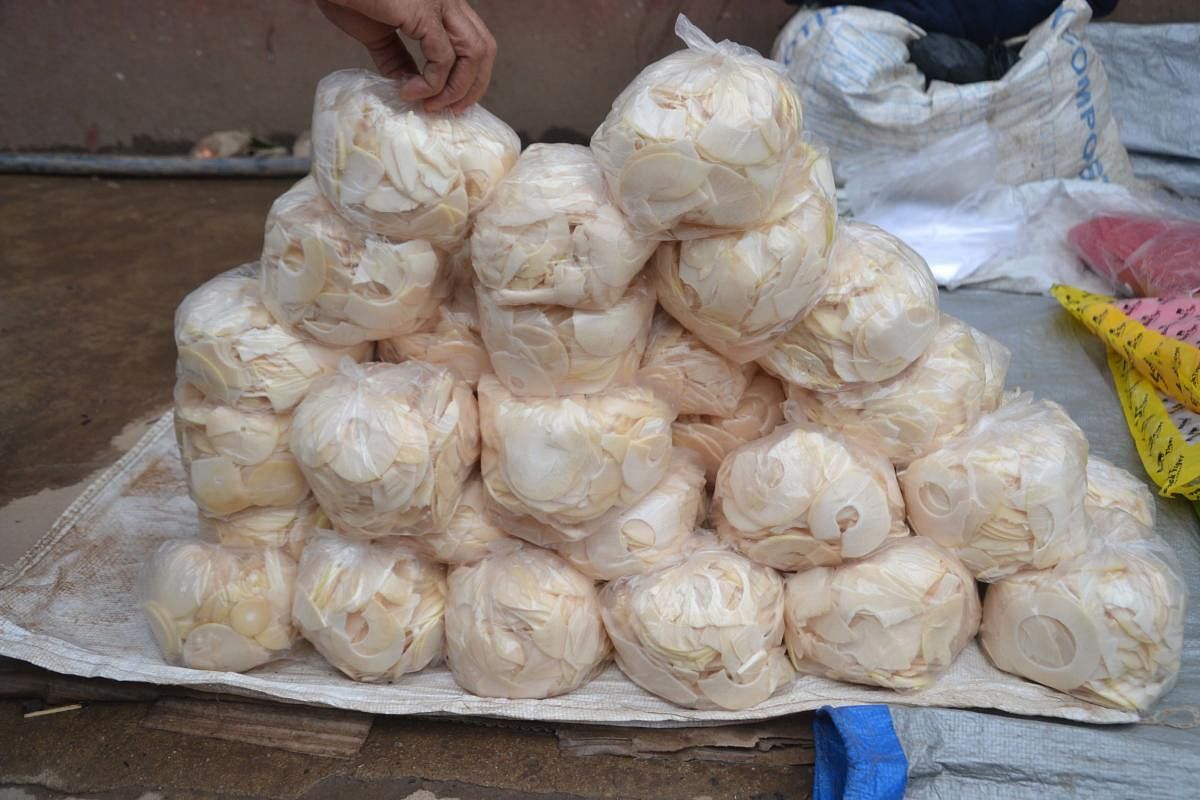

While the monsoon in Kodagu means day-long rains, marshy roads and no festivities, people still look forward to it. The land comes alive with a variety of wild plants, mushrooms, and even crabs and fishes — ingredients for perfect monsoon delights.
As monsoon was the prime season to sow paddy — Kodagu’s main crop in the days of yore — people had no time for any other activity. So, this season was regarded as inauspicious and no ceremonies or celebrations were held. In between, the people would forage for these seasonal treats and prepare mouth-watering delicacies.
The aromas of baimbale curry (bamboo shoots curry), kummu curry (mushroom curry), kembu curry (colocasia curry), njand curry (crab curry), bhel meen curry (fish found in flooded paddy fields), pole meen curry (stream fish curry), therme thoppu palya (fiddlehead fern fry) are indicative of monsoon in this district located in the Western Ghats. These dishes are exclusively prepared during the wet months.
“The foremost reason these dishes are consumed only during the monsoon months is that the main ingredients such as aal kummu, baimbale are only available during this season,” says Chef Naren Thimmaiah.
According to Naren, cooking styles in each region would have developed purely on a trial-and-error basis. “Our elders would have realised when to eat what, the good and bad traits of a dish through experience,” he adds.
Purple delight
Unique sweet dishes prepared during this season are maddh payasa and maddh putt from maddh thoppu (Justicia Wynaadensis). Maddh translates to medicine in Kodava language and thoppu is leaf. The extract obtained from the leaves and stems of this plant imparts a beautiful, deep bluish-purple colour to the dish.
These dishes are prepared and consumed only on Kakkada padinett, the eighteenth day of kakkada month (early August) in the Kodava calendar, when this plant is believed to have accumulated 18 medicinal properties.
The plant, rich in antioxidative and anti-inflammatory properties, is said to improve overall health. Its anti-microbial properties are also said to boost immunity during the monsoon months, when one is more likely to fall ill.
Another quintessential monsoon dish is baimbale curry made from bamboo shoots. The shoots are cut into small pieces and soaked in water for two days to remove the acidic toxins. The shoots are said to have anti-inflammatory, anti-ulcer, anti-diabetic and anti-oxidant properties. The baimbale curry is best had with akki roti called otti.
Surprise yields
Mushrooms, called kummu, also make great ingredients. These edible fungi grow in small patches and gathering them is a fun activity but it takes a trained eye to distinguish between edible and poisonous mushrooms.
Another Kodava delicacy is prepared from fiddlehead ferns, called therme thoppu. These ferns are found near the banks of water bodies such as ponds, streams and rivers. Only the tender shoots of these wild ferns are selectively picked. The easiest way to cook it is to saute it with onions, dried chillies and salt. It is best had with otti.
Like therme thoppu, kembu (colocasia) is generally found near water bodies and marshy lands. There are three varieties of kembu: red stemmed (chonda) kembu, green stemmed kembu and mara kembu. Mara kembu grows under the shelter of large trees. While Tulunadu is famous for the patrodes made from colocasia leaves, in Kodagu people mainly prepare curry using it.
With the onset of the monsoon, people also make dishes from jackfruit seeds.
Apart from these seasonal plants, people also get a good catch of crabs and fish in the flooded paddy fields and streams. Piping hot curries prepared from crabs and fish add to the charm of the monsoon months.
“All the traditional food prepared during the chilly monsoon season adds heat to the body. Also, pepper is used widely in the region, which again adds heat to the body,” Naren says.
Naren explains that as the people were expected to work in the rains and were most likely to get cuts and wounds, the food consumed would build up body temperature and aid in quicker healing of the wounds. “There were no tablets available then, the foods themselves had medicinal values,” he says.
Preserved for future use
While these dishes are prepared only in the rainy season, bamboo shoots, jackfruit seeds, hog plums (ambatte) and fish are preserved for later use.
Bamboo shoots and hog plums are stored in brine; fish are coated with salt, smoked and dried.
These foods are so culturally ingrained that people staying elsewhere either make it a point to go to Kodagu to procure these food items or get their relatives to send across these delicacies.
“The food items sourced from Kodagu have an altogether different taste. So, preparing dishes by getting the ingredients from Kodagu is a special feeling,” says Sudha Poovaiah, who is settled in Bengaluru.